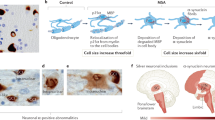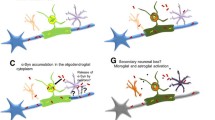Abstract
Multiple system atrophy (MSA) is a neurodegenerative disease with two motor phenotypes: parkinsonian (MSA-P) and cerebellar (MSA-C). To elucidate whether in addition to the motor abnormalities there are other significant differences between these phenotypes, we performed a retrospective review of 100 patients (61 males, 39 females) with a diagnosis of possible (12 %), or probable (88 %) MSA. Four patients eventually had post-mortem confirmation (i.e., definite MSA). Sixty percent were classified as having MSA-P and 40 % as MSA-C. MSA-C and MSA-P patients had similar male prevalence (60 %), age of onset (56 ± 9 years), and frequency of OH (69 %). Brain MRI abnormalities were more frequent in MSA-C patients (p < 0.001). Mean survival was 8 ± 3 years for MSA-C and 9 ± 4 years for MSA-P patients (p = 0.22). Disease onset before 55 years predicted longer survival in both phenotypes. Initial autonomic involvement did not influence survival. We conclude that patients with both motor phenotypes have mostly similar survivals and demographic distributions. The differences here identified could help counseling of patients with MSA.

Similar content being viewed by others
References
Damon-Perrière N, Foubert-Samier A, De Cock VC, Gerdelat-Mas A, Debs R, Pavy-Le Traon A, Senard JM, Rascol O, Tison F, Meissner WG (2012) Assessment of the Scopa-Aut questionnaire in multiple system atrophy: relation to UMSARS scores and progression over time. Parkinsonism Relat Disord 18(5):612–615. doi:10.1016/j.parkreldis.2011.12.009
Gilman S, Wenning GK, Low PA et al (2008) Second consensus statement on the diagnosis of multiple system atrophy. Neurology 71(9):670–676. doi:10.1212/01.wnl.0000324625.00404.15
Iodice V, Lipp A, Ahlskog JE et al (2012) Autopsy confirmed multiple system atrophy cases: mayo experience and role of autonomic function tests. J Neurol Neurosurg Psychiatry 83(4):453–459. doi:10.1136/jnnp-2011-301068
Katzenschlager R, Hughes A, Evans A, Manson AJ, Hoffman M, Swinn L, Watt H, Bhatia K, Quinn N, Lees AJ (2005) Continuous subcutaneous apomorphine therapy improves dyskinesias in Parkinson’s disease: a prospective study using single-dose challenges. Mov Disord 20:151–157
Kim HJ, Jeon BS (2012) Multiple system atrophy with prolonged survival. Mov Disord 27(14):1834. doi:10.1002/mds.25289
Kollensperger M, Geser F, Ndayisaba JP et al (2010) Presentation, diagnosis, and management of multiple system atrophy in Europe: final analysis of the European multiple system atrophy registry. Mov Disord 25(15):2604–2612. doi:10.1002/mds.23192
Kraft E, Trenkwalder C, Auer DP (2002) T2*-weighted MRI differentiates multiple system atrophy from Parkinson’s disease. Neurology 59(8):1265–1267
O’Sullivan SS, Massey LA, Williams DR et al (2008) Clinical outcomes of progressive supranuclear palsy and multiple system atrophy. Brain 131(Pt 5):1362–1372. doi:10.1093/brain/awn065
Petrovic IN, Ling H, Asi Y et al (2012) Multiple system atrophy-parkinsonism with slow progression and prolonged survival: a diagnostic catch. Mov Disord 27(9):1186–1190. doi:10.1002/mds.25115
Stemberger S, Wenning GK (2011) Modelling progressive autonomic failure in MSA: where are we now? J Neural Transm 118(5):841–847. doi:10.1007/s00702-010-0576-3
Tada M, Onodera O, Tada M et al (2007) Early development of autonomic dysfunction may predict poor prognosis in patients with multiple system atrophy. Arch Neurol 64(2):256–260. doi:10.1001/archneur.64.2.256
Visser M, Marinus J, Stiggelbout AM, Van Hilten JJ (2004) Assessment of autonomic dysfunction in Parkinson’s disease: the SCOPA-AUT. Mov Disord 19(11):1306–1312
Watanabe H, Saito Y, Terao S et al (2002) Progression and prognosis in multiple system atrophy: an analysis of 230 Japanese patients. Brain 125(Pt 5):1070–1083
Wenning GK, Tison F, Seppi K et al (2004) Development and validation of the Unified Multiple System Atrophy Rating Scale (UMSARS). Mov Disord 19(12):1391–1402. doi:10.1002/mds.20255
Wenning GK, Geser F, Krismer F et al (2013) The natural history of multiple system atrophy: a prospective European cohort study. Lancet Neurol 12(3):264–274. doi:10.1016/S1474-4422(12)70327-7
Acknowledgments
National Institutes for Health (NIH) Rare Diseases Clinical Research Network Grant (U54 S065736 to LJNK, JM and HK) and the Dysautonomia Foundation, Inc. (to DR, JAP, NG, and HK). The Rare Autonomic Disorders Consortium is a part of the National Institutes of Health (NIH) Rare Diseases Clinical Research Network (RDCRN), supported through collaboration between the NIH Office of Rare Diseases Research (ORDR) at the National Center for Advancing Translational Science (NCATS), and the NINDS. The content is solely the responsibility of the authors and does not necessarily represent the official views of the National Institutes of Health.
Conflict of interest
The authors report no conflict of interests relevant to this article.
Author information
Authors and Affiliations
Corresponding author
Rights and permissions
About this article
Cite this article
Roncevic, D., Palma, JA., Martinez, J. et al. Cerebellar and parkinsonian phenotypes in multiple system atrophy: similarities, differences and survival. J Neural Transm 121, 507–512 (2014). https://doi.org/10.1007/s00702-013-1133-7
Received:
Accepted:
Published:
Issue Date:
DOI: https://doi.org/10.1007/s00702-013-1133-7




